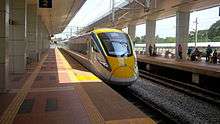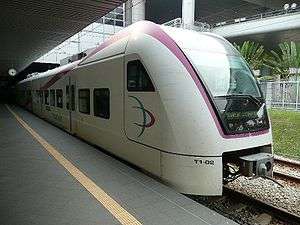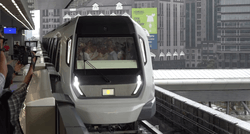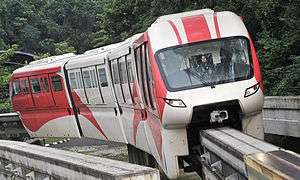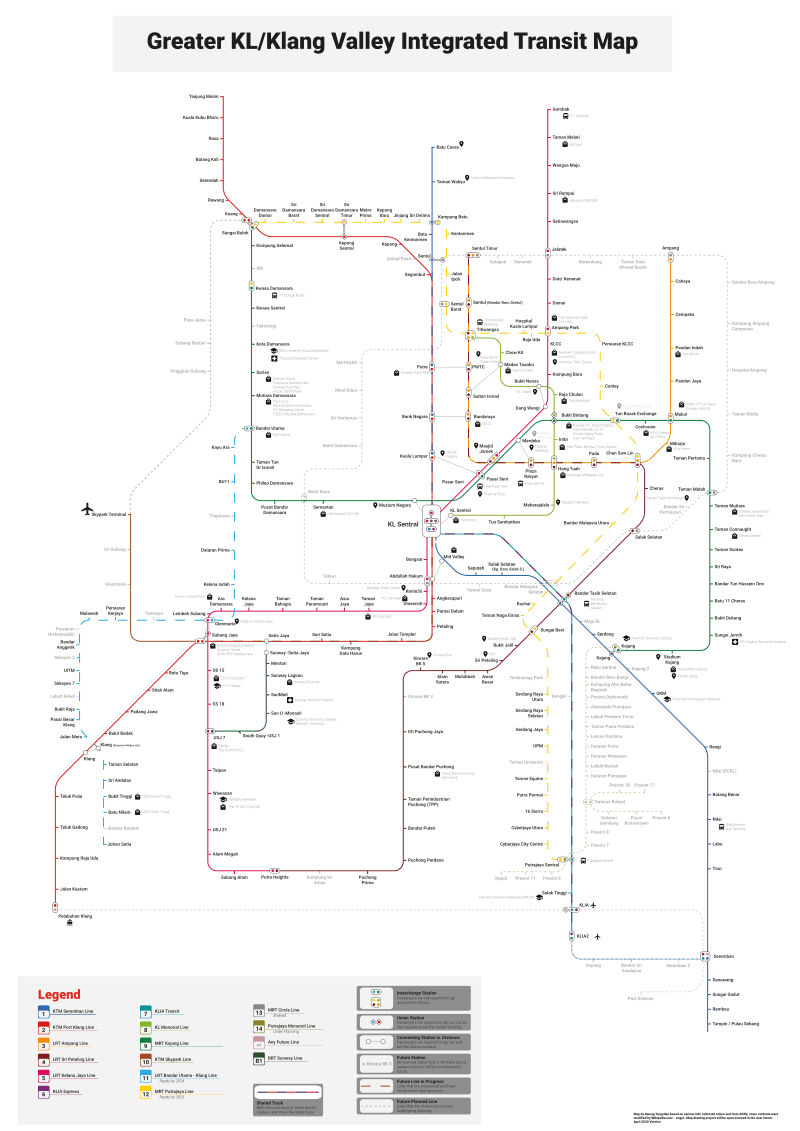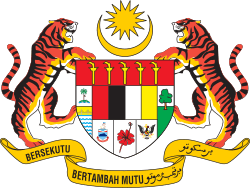Rail transport in Malaysia
Rail transport in Malaysia consists of heavy rail (including commuter rail), light rapid transit (LRT), mass rapid transit (MRT), monorails, airport rail links and a funicular railway line. Heavy rail is mostly used for intercity passenger and freight transport as well as some urban public transport, while rapid transit is used for intra-city urban public transport in Kuala Lumpur, the national capital, and the surrounding Klang Valley region. There are two airport rail link systems linking Kuala Lumpur with the Kuala Lumpur International Airport and Sultan Abdul Aziz Shah Airport. The longest monorail line in the country is also used for public transport in Kuala Lumpur, while the only funicular railway line is in Penang.
| Rail transport in Malaysia | |
|---|---|
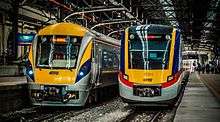 Class 91 of KTM ETS for Intercity Express and Class 92 of KTM Komuter at Kuala Lumpur Railway Station. | |
| Operation | |
| National railway | Keretapi Tanah Melayu |
| Major operators | 1 2 10 1 2 ETS 3 4 5 8 9 6 7 |
| Statistics | |
| Ridership | 694,057 (2017) [note 1] |
| System length | |
| Total | 1,833 kilometres (1,139 mi) |
| Double track | 767 km (477 mi) |
| Electrified | 767 km (477 mi) |
| Track gauge | |
| Main | 1,000 mm (3 ft 3 3⁄8 in) |
| High-speed | 1,000 mm (3 ft 3 3⁄8 in) 1,435 mm (4 ft 8 1⁄2 in) |
| Metre gauge 1,000 mm (3 ft 3 3⁄8 in) | 1,776 km (1,104 mi) |
| Standard gauge 1,435 mm (4 ft 8 1⁄2 in) | 199.5 km (124.0 mi) |
| Straddle beam monorail | 8.6 km (5.3 mi) |
The railway network covers most of the 11 states in Peninsular Malaysia. In East Malaysia, only the state of Sabah has railways. The network is also connected to the Thai railway 1,000 mm (3 ft 3 3⁄8 in) network in the north. If the Burma Railway is rebuilt, services to Myanmar, India, and China could be initiated.
Railway infrastructure
Metre gauge rail
Peninsular Malaysia
The intercity railway network in Peninsular Malaysia consists of two main lines: The KTM West Coast Line between Singapore and Padang Besar, Perlis, on the Malaysian-Thai border, and the KTM East Coast Line between Gemas in Negeri Sembilan and Tumpat in Kelantan. There are also several branch lines – between Kuala Lumpur and Port Klang, Batu Junction and Batu Caves, Bukit Mertajam and Butterworth, Kempas and Tanjung Pelepas, and Kempas and Pasir Gudang. The entire 1,699 km network uses 1,000 mm (3 ft 3 3⁄8 in) metre gauge tracks. The network uses a ballasted setup with locally manufactured concrete sleepers. Since the early 1980s, companies formed via international collaboration, such as Mastrak Sdn Bhd had been producing these sleepers via technology transfer.[2][3][4] In the five years period of 1982-1987 alone, it was estimated that about 500,000 pieces of sleepers had been laid for the Kerdau-Jerantut and Sungai Yu-Tumpat lines, giving clear preference due to its advantages over wooden sleepers. This was also evident in the changes made by Sabah State Railway in 2006 for the network under their control.
The network is linked with the Thai railway network at Padang Besar.
A total of 438 km of the network is double-tracked and electrified. They include portions of the West Coast Line between Gemas and Padang Besar and the entire Port Klang branch line as well as Batu Caves branch line. The double-tracked and electrified portions between Tanjung Malim and Pulau Sebang/Tampin, and between Padang Besar and Padang Rengas, as well as the Port Klang, Batu Caves and Butterworth branch lines are used for commuter rail services.
Double tracking and electrification of the stretch of the Batu Caves branch line between Sentul and Batu Caves were completed, having added 7.5 km of double-tracked and electrified sections to the network in 2010. Double tracking and electrification of the West Coast line between Ipoh and Padang Besar started in January 2008 and was completed by November 2014,[5] adding a further 329 km of double-tracked and electrified railway to the network.
Malaysia's national petroleum company Petronas owns a railway line which links its oil refinery complex and the nearby town of Kerteh, Terengganu, with the petrochemical complex in Gebeng, Kuantan, and Kuantan Port near Kuantan, Pahang. The line is mainly used to transport petroleum products, but it has been opened up recently for general freight transport, with operation being conducted by KTM. There have been proposals to extend the line to connect with the KTM line at Mentakab, and there are suggestions to go as far as Kuala Terengganu and Tumpat.
Sabah
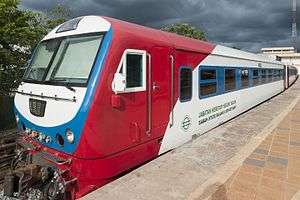
There is a 134 km (83 mi) railway line linking Tanjung Aru near Kota Kinabalu and Tenom in the interior of Sabah state. The line is the only railway on the island of Borneo. Normal passenger trains operated by the Sabah State Railway Department. The line has been suffering from lack of maintenance for many years and in 2006, the Malaysian Government funded rehabilitation works for the line. A pipe dream is to have a railway line from Kota Kinabalu to Kuching through Brunei though the cost of this would mean seeking funding from Brunei.
Standard gauge rail lines
Malaysia's only standard gauge rail lines are currently found within Kuala Lumpur and the Klang Valley.
Ekspres Rail Link (ERL)
One of Malaysia's two fastest rail lines is the 57 km (35 mi) standard gauge airport rail link between Kuala Lumpur and the Kuala Lumpur International Airport. Depending on which definition used, this line may not be considered a high speed line because the maximum speed used is 160 km/h (99 mph). The line was constructed by Express Rail Link, which also operates the two train services which use the line, namely the KLIA Ekspres and KLIA Transit.
Light Rapid Transit (LRT)
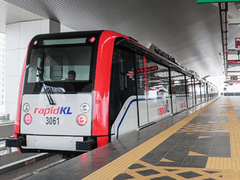
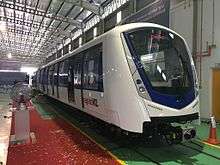
There are currently two operational light rail systems in Malaysia. One is used as the major public transport system in the Klang Valley, while another acts as a automated people mover at the Kuala Lumpur International Airport to ferry passengers from the Main Terminal Building and the satellite building.
The LRT system in the Klang valley consist of three LRT lines which are the Kelana Jaya Line, the Ampang Line and Sri Petaling Line. The Kelana Jaya Line is a driver-less automatic system and is 46.4 km (29 mi) long, running between the northeastern suburbs of Kuala Lumpur and Petaling Jaya to the west of Kuala Lumpur, and south towards Subang Jaya. It is mostly elevated except for a 4 km (2.5 mi) stretch where it goes underground and a short at-grade stretch in the north. The Kelana Jaya Line was completely operational from June 1999. The older Ampang Line and Sri Petaling Line share a common track between the suburb of Sentul in the north of Kuala Lumpur and Chan Sow Lin in the central region, before branching out to their respective termini. The 15 km (9 mi) Ampang Line travels to Ampang in the east and the 37.6 km (23 mi) Sri Petaling Line travels towards southern Kuala Lumpur and onwards to Puchong. The system is mostly a mixture of at-grade and elevated tracks outside the city, and is completely elevated with it runs through the city. Both lines were completely opened in 1998. The Kelana Jaya Line and the Sri Petaling Line both terminate at Putra Heights.
The automated people mover system at Kuala Lumpur International Airport, called the "Aerotrain", is a simple people-mover shuttle system running along two 1,286 m (4,219 ft) guiderails between the Main Terminal Building and Satellite Building. The two ends of the guiderails are elevated while the middle portion goes under the main airport taxiway. Each rail has a three-car automatic driver-less train.
Mass Rapid Transit (MRT)
In December 2010, the government approved the implementation of an MRT project and announced preliminary plans for the first line, stretching 51 km (32 mi) from Sungai Buloh to Kajang through 35 stations. The line, known as Kajang Line, will pass through the city centre and will serve densely populated suburban areas including Kota Damansara, Mutiara Damansara, Bandar Utama, Taman Tun Dr Ismail, Bukit Damansara, Cheras, Bandar Tun Hussein Onn and Balakong, with a total catchment population of 1.2 million people. The Kajang Line entered full revenue service on July 2017.
Monorail
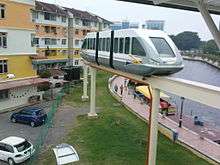
Malaysia's major monorail system is used for public transport in Kuala Lumpur. It is 8.6 km (5.3 mi) long, running from Titiwangsa in the north of central Kuala Lumpur, to KL Sentral just to the south of the city centre. It has 11 stations. The line consists of two parallel rails for most of the way except at the end stations where switches merge the two rails into a single rail before entering the station. The entire network is elevated. The system uses two-car and four-car trains which were manufactured in Malaysia. It is operated by Rapid Rail.
There are proposals to construct monorails in Penang and Johor Bahru. The federal administrative centre of Putrajaya was also supposed to have a monorail network and the main station and several metres of track have been built. The project was postponed because of the then low population of the city. However, the Putrajaya Monorail projects are under plans to be revived.
Malacca has been proposed to build a 1.8 km (1.1 mi) monorail line for urban mass-transit. The monorail has been hit by a number of setbacks, including the suspension of the service after a British couple, Anne and James Croft, had to be rescued by firefighters when the monorail stopped unexpectedly between stations. Following this incident a number of safety upgrades have been suggested including the purchase of cherry pickers in case of any further stoppages.[6] After 4 years being suspended since 2013 due to technical problems, the Malacca Aerorail service begin operating again on 4 December 2017.[7]
Cable Car Rail System (Funicular)
The Penang Hill Railway in Penang is the only cable car rail system type (funicular) in Malaysia. The line is made up of two separate sections, with the total length at 1.2 km (0.75 mi). Both sections are single lines with passing loops at midway. The tracks are metre gauge and have an incline of over 50%.
Other modes of transport
Cable Car
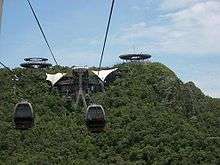
The 2.4 km Awana Skyway is an aerial tramway type cable car connecting Awana/Sri Layang and Genting Grand Hotel, Genting Highlands in Malaysia, was built in 1975 and was then Malaysia’s very first aerial lift cable car transport system before Genting Skyway is officially opened on 21 February 1997. It has ceased operations on 1 April 2014 to make way for the construction of a new cable car system using gondola lift type. The Genting Skyway is a gondola lift connecting Gohtong Jaya and Resorts World Genting in Malaysia. Its lower station, located approximately 51 kilometres (32 mi) northeast of Kuala lumpur, comprises a 5-storey station building and a 10-storey car park while its upper station is located at the Highlands Hotel. The Langkawi Cable Car is a gondola lift is one of the major attractions in Langkawi Island, Kedah, Malaysia. It provides an aerial lift service from the Oriental Village at Teluk Burau to the peak of Gunung Machinchang, which is also the location of the Langkawi Sky Bridge. The total length is 2.2 km (1.4 mi). It was officially opened in 2003.
Rail-based public transport in Kuala Lumpur
|
Railway operators
Keretapi Tanah Melayu Berhad
The main intercity passenger train operator is Keretapi Tanah Melayu (KTM), a corporation owned by the Malaysian government. It operates the diesel-hauled KTM Intercity passenger trains on the entire East Coast Line and the southern portion of the West Coast Line, and the electrified KTM ETS passenger trains along the remaining portion of the West Coast Line, between Padang Besar and Gemas and the Butterworth branch line. KTM also operates freight trains along both railway lines. Under the KTM Komuter, KTM operates commuter rail services along double-track and electrified portions of the West Coast Line between Tanjung Malim in Perak and Pulau Sebang in Negeri Sembilan, and between Padang Besar in Perlis and Padang Rengas in Perak, as well as the Butterworth, Port Klang and Batu Caves branch lines.
Besides its own network, KTM also operates trains on the Kerteh-Kuantan railway under contract with Petronas, the owner of the line.
Sabah State Railway
The Sabah State Railway, previously the North Borneo Railway, is the only state department in Malaysia to operate a railway service. It operates passenger and freight services along the 134 km railway line between Tanjung Aru and Tenom in East Malaysia.
Express Rail Link Sdn Bhd
The Express Rail Link (ERL) is a private company that was set up to develop and operate the high-speed railway between Kuala Lumpur's KL Sentral station and the Kuala Lumpur International Airport. It operates two services along the 57 km standard gauge line, the non-stop KLIA Ekspres and the commuter-like KLIA Transit. Trains on the two services can reach a maximum speed of 160 km/h and are the fastest in Malaysia. Besides trains, the company also provides check-in facilities at its Kuala Lumpur City Airport Terminal at KL Sentral. Except for check-in baggage of passengers, Express Rail Link does not handle any cargo.
Rapid Rail
Rapid Rail was set up by Prasarana Malaysia to operate the rapid transit public transport service in the Klang Valley. Prasarana Malaysia is fully owned by Ministry of Finance Incorporated, the corporate arm of the Malaysian Ministry of Finance. The company currently operates one MRT line, three LRT lines and one monorail line in Kuala Lumpur under the Rapid KL brand, namely the Kajang Line, Ampang Line, Sri Petaling Line, Kelana Jaya Line and KL Monorail.
Other operators
- Malaysia Airports (Sepang) Berhad: The main operator of airports in Malaysia is also the operator of the Aerotrain at Kuala Lumpur International Airport.
- Penang State Government: The state government of Penang operates the Penang Hill Railway.
History
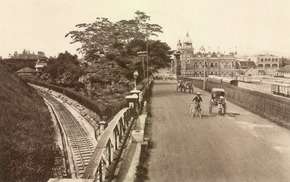
Railways in Malaysia began because of the need to transport tin from mines in the hinterland of the West Coast states of Peninsular Malaysia to coastal ports. The first railway line, which was opened on 1 June 1885, was about 13 km long and ran between Port Weld and Taiping, the heart of the tin-rich Larut Valley in Perak state.[8] The second line was opened a year later to link Kuala Lumpur, again the center of tin-mining activities in the Klang Valley, and Klang and subsequently to Port Swettenham (Port Klang today).
Timeline
- 1885 – The first railway line in Malaya between Taiping and Port Weld is officially opened on 1 June.
- 1886 – Opening of line between Kuala Lumpur and Klang.
- July 1888 – The first train crash in the country occurred in Sungai Kerawai near Teluk Anson, Perak.
- 1891 – Opening of the line between Seremban and Port Dickson.
- 1893 – Teluk Anson to Tapah Road line opened.
- 1896 – Federated Malay States Railway created, merging the operations of the initial four lines.
- 1900 – Opening of the Victoria Railway Bridge across Perak River in Perak.
- 1903 – Line between Tank Road and Woodlands in Singapore opened for service.
- 1909 – The West Coast Line between Prai in Penang state and Johor Bahru completed and opened.
- 1910 – The first stretch of the East Coast Line between Gemas and Bahau is opened.
- 1923 - Johor-Singapore Causeway was opened, connecting Singapore's railway network with the rest of Malaya.
- 1931 – East Coast Line between Tumpat and Gemas completed with the opening of the last stretch between Gua Musang and Kuala Gris in Kelantan.
- 3 August 1995 – The first KTM Komuter trains, Malaysia's first to be run on electricity, began taking passengers between Kuala Lumpur and Rawang. Entire commuter train network opened to passengers with the final stretch to Seremban becoming operational on 18 December 1995.
- 14 April 2002 – Malaysia's first high-speed train, the KLIA Ekspres between KL Sentral and Kuala Lumpur International Airport was officially launched. At the same time, the Kuala Lumpur City Air Terminal in KL Sentral was also opened.
- 1 July 2011 – KTM's Tanjong Pagar and Bukit Timah railway stations in Singapore were closed. All Singapore operations were moved to Woodlands Train Checkpoint.
- 2013 - The stretch of rail between Seremban and Gemas was double tracked and electrified. ETS services ran the same year.
- 2014 - The stretch of rail between Ipoh and Padang Besar was double tracked and electrified. ETS services ran the following year.
Projects and expansion plans
Gemas-Johor Bahru Electrification and Double-Tracking
The MYR 8 billion contract was expected to be tendered out by end 2008 pending a mid-term review of the Ninth Malaysia Plan. The project would have included building over 200 km of parallel railway tracks, including stations, depots, halts, yards and bridges and cover systems such as electrification, signalling and communications.[9] This included the realignment between Pulau Sebang, Melaka to Gemas section.
On May 2009, Global Rail Sdn Bhd, a relatively small contractor and its Chinese partner, China Infraglobe submitted a proposal to the Government to build and upgrade tracks from Gemas to Johor Bahru at a cost of MYR 5 billion. According to them, the project would be on a private finance initiative basis and the plan submitted to the Finance Ministry later in June 2009 was conditional upon signing over mineral rights in Johor State.[10]
On 29 January 2011, Transport Minister Datuk Seri Kong Cho Ha said that the Gemas-Johor Bharu double-tracking and electrification project was expected to start that year. He added that the Government hoped to appoint the contractor for the project that year and Malaysia was still in the midst of talking with China Railway Construction, but nothing was confirmed yet. Kong said two consultants had been appointed, a design consultant and an independent checker, to monitor the project. The construction of the 197 km of tracks, at an estimated cost between MYR 6 billion and MYR 7 billion, would take three years.[11]
On 27 October 2015, the public display exercise, required for all development of new railways under Section 84 of Malaysia's Land Public Transport Act 2010, for the Gemas-Johor Bahru Electrification Double Tracking Project began and will run until 27 January 2016. According to documents on display to the public, construction is expected to begin in 2016 and be completed in 2021.[12]
The Chinese company CRCC has been awarded to build the Gemas-Johor Bahru Electrification and Double-Tracking project. Construction on the project began in Jan 2018.[13] It is expected to be completed by the end of 2021.
The length of the line to be electrified and double-tracked is 197 km between Chainage 563.040 at Gemas and Chainage 754.180 at Johor Bahru. The project includes the construction of 11 stations at Segamat, Genuang, Labis, Bekok, Paloh, Kluang, Mengkibol, Rengam, Layang-Layang, Kulai and Kempas Baru, and 3 future stations at Tenang, Chamek and Senai. The upgraded line is supposed to cater for at least 22 services daily involving KTM ETS, KTM Intercity and shuttle train services as well as KTM Komuter.
The documents displayed also stated that the electrification for the stretch will have the same specifications as that of the Seremban-Gemas stretch, at 25 kV AC 50 Hz single phase and supplied via an overhead catenary. Train operations for this stretch will be integrated with the Train Control Centres at KL Sentral and Gemas. The design speed for the tracks is 160 km/h.
Penang Transport Master Plan
The Penang Transport Master Plan is a propsed, mixed-mode transport scheme for the state of Penang in norther Peninsular Malaysia conceived by the Penang state government, consisting of light rail, bus and rapid transit systems. The Bayan Lepas light rapid transit (LRT) line will be the first LRT line in Penang. It is the first and one of the priority projects of the Master Plan. The proposed 22 km (14 mi) will exclusively serve the Penang Island, and will link the city centre of George Town in the north with the industrial town of Bayan Lepas to the south of the island.
East Coast Rail Link
The East Coast Rail Link (ECRL) is a planned standard gauge double-track railway link infrastructure project connecting Port Klang on the Straits of Malacca to Kota Bharu in northeast Peninsular Malaysia via Putrajaya, connecting the East Coast Economic Region states of Pahang, Terengganu and Kelantan to one another, and to the Central Region of the Peninsular's west coast. The project was proposed to provide high speed inter-city rail service to the east coast states and to complement the KTM East Coast Line. Currently, Terengganu is the only state in Peninsular Malaysia without a passenger railway system, as the KTM East Coast Line on services Pahang and Kelantan.
Johor Bahru-Singapore Rapid Transit System
The Johor Bahru-Singapore Rapid Transit System (RTS Link) is a planned cross-border rapid transit system that would connect Woodlands, Singapore and Johor Bahru, Malaysia, crossing the Straits of Johor.
The rapid transit system will have two stations, with the Singaporean terminus located at Woodlands North station (interchanging with the Singapore MRT system) and the Malaysia terminus at Bukit Chagar station (interchange with the proposed Iskandar Malaysia BRT system). Both stations will have co-located Singaporean and Malaysian customs, immigration and quarantine facilities.
When built, the RTS Link will be the second rail link between the two countries after the KTM Intercity Shuttle Tebrau, and the first high-capacity international metro system to be built. The RTS Link is expected to replace the railway line and shuttle train services between JB Sentral and Woodlands Train Checkpoint, completing the withdrawal of KTM operations from Singapore.
Kuala Lumpur Light Rapid Transit (LRT) system expansion
On 29 August 2006, then Malaysian Deputy Prime Minister Mohd Najib Abdul Razak announced a RM10 billion plan to expand Kuala Lumpur's public transport network. The plan included extending the existing Kelana Jaya Line from Kelana Jaya via Subang Jaya to Putra Heights and the Sri Petaling Line from Sri Petaling to Putra Heights via Puchong.
Prasarana Malaysia, the owner of the LRT lines, signed an agreement on 13 October 2006 with Bombardier and a Malaysian company joint venture for the purchase of 22 light rail vehicle sets with an option for another 13 for RM1.2 billion for the Kelana Jaya Line. The 22 vehicles will have four cars each and will boost the carrying capacity of the fleet by 1,500 people. The 22 sets will be delivered from August 2008. The new rolling stock was put into full operation by 2016. end-2010. As for the Ampang and Sri Petaling Line, the rolling stock currently consists of a fleet of 50 new trains that are deployed to increase the capacity of the line and provide a better service. Each of the new trains is six cars long and provided by CSR Zhuzhou of China.
The entire project and fleet expansion was completed and have been in full operation since 30 June 2016.
A third LRT system is under construction which, once completed, will link the city centre with the cities of Shah Alam and Klang. The line, which spans 37 km, has 25 permanent stations under construction, five of them being kept as provisional stations for the future.[14] The LRT line is planeed to be fully operational by 2026.
Kuala Lumpur-Singapore High Speed Railway
Just after the completion of the KLIA Ekspres, the project proponent YTL Corporation Berhad proposed a high-speed rail link between Kuala Lumpur and Singapore. At that time, Prime Minister Dr Mahathir Mohamad said Malaysia could not afford such an expensive project. YTL again proposed the project in 2006[15] and as of June 2007, the Malaysian Government said the feasibility of the proposal was still being studied.[16] The RM8 billion project would slash rail travel time from more than 6 hours by Keretapi Tanah Melayu (KTM) to about 90 minutes by high speed rail. The main stumbling blocks, apart from costs, appears to be the Johor-Singapore Causeway which Mahathir had once hoped to replace with a 'scenic bridge'. There were doubts about the capacity of such a curved bridge to carry a rail line and YTL having to use KTM land which runs from Woodlands to Keppel. Redevelopment of this land in Singapore could probably help fund the proposed railway if the various parties involved each had a stake in each other. If the Causeway remains or a straight bridge is one day built to replace it, there should be no difficulty to have a high speed line on either. The high speed line proposal, like the bridge proposal, appears to have reached a stumbling block which only can be overcome at the highest political levels where other bilateral issues have to first be resolved or dealt with at the same time.
As of December 2007, YTL Corporation Group managing director, Tan Sri Francis Yeoh Sock Ping, express great confidence that the project will be approved by both governments. JPMorgan added that almost all regulatory road blocks in building the railway is resolved. The key consideration in the project approval rests in the role of developing the Iskandar Development Region.[17][18] On January 2008, the transport minister, Datuk Seri Chan Kong Choy said that the government is still looking in the proposal and had yet to make a final decision. He added that the train would be broad gauge and will run at 350 km/h.[19] If this is the case, new lines need to be laid down as the currently ERL tracks are only standard gauge. In March 2008, the government is still studying the social impact of the project through the Economic Planning Unit. The Deputy Prime Minister stress out that the risk and funding of the project will squarely rest on the private sector.[20]
Siemens, a major railroad partner in Malaysia has express interest in giving out solutions to the project. They have proposed Velaro trains which has a top speed of 350 km/h as a solution for the project.[21]
On 22 April 2008, the government announce that the project was put on hold indefinitely due to high cost. The government said that the model that YTL Corp. was proposing requires the government to borne a significant amount of financing.[22] According to news reports, the decision came at the time of political upheaval due to the recent general election, supported by voices like Keretapi Tanah Melayu who opposes such projects and consideration to protect Kuala Lumpur International Airport.[23]
On March 2009, it was reported the YTL was considering to revive the project again. It will seek to build the rail line on the coastline of Peninsular Malaysia rather than an earlier proposal of building on the existing track.[24] It was subsequently announced by then Malaysian's Prime Minister, Najib Razak, in September 2010. Singapore's Prime Minister, Lee Hsien Loong, officially agreed in February 2013 to go ahead and the high-speed rail project was expected to be completed by 2026. Following the victory of Pakatan Harapan in the 2018 Malaysian general elections, then newly-elected Prime Minister Mahathir Mohamad announced the project will be revised.[25] Among revisions being explored to reduce costs, was to align the route to the existing meter gauge Keretapi Tanah Melayu (KTM) line to allow trains to run at 200 km/h with some upgrades in order to trim travel time to 2 hours and 10 minutes and lay a standard gauge track in parallel, with a fork running to Jurong East so that bilateral agreement is not violated.[26] Both nations negotiated and agreed to postpone the construction of the line and plan to open the service for operations by January 2023.
According to PLANMalaysia, the northern high-speed rail corridor will be build along North-South Expressway and the stations will be at Tanjung Malim, Tapah, Ipoh, Taiping and terminated at Butterworth .[27]
Sarawak rail transportation projects
Terengganu and Sarawak are the only two states in Malaysia that do not have railway infrastructure. In Sarawak, a railway line existed before the Second World War, but the last remnants of the line were dismantled in 1959.[28]
As part of Sarawak Corridor of Renewable Energy project, the government is planning a 320 km railway track between Similajau in Bintulu Division and Tanjung Manis in Mukah Division. The cost and plans for the project timeline is yet to be revealed.[29]
Another railway line, the Sarawak Railway Line is a proposed project by the Malaysian government to establishing a railway network in the state of Sarawak.[30][31] In 2008, it was reported the project will be ready in 2015 but still no signs of development by the government until present.[32]
The Kuching LRT system is a proposed light rapid transit (LRT) system network in Kuching, the capital city of Sarawak. as one of the methods to ease traffic congestion in the city.[33][34] The proposed LRT lines will connect Kuching to Samarahan and Serian.[35] The construction of the RM10.8 billion project was expected to commence by 2019 and was scheduled to be operational by 2024.[36]
Sabah rail transportation projects
On 17 September 2015, it was announced that the Sabah State Railway will be extended to cover the northern and east coast areas, mainly to major towns of Kudat, Sandakan and Tawau.[37][38] On 21 March 2017, around RM1 million has been allocated for the project study.[39] Once the project is complete, there is also a proposal to connecting the rail networks of Sabah and Sarawak in Malaysia with the provinces of Kalimantan in Indonesia that will be called as "Trans-Borneo Railway",[40] as Indonesia were currently developing the railway network on their side.[41][42]
A proposed monorail line project is to be constructed in the Kota Kinabalu area by the Sabah state government.[43][44] The proposals generated mixed reactions between the mayor and politicians.[45][46][47][48] As reported in the government website, the project was in the ground breaking process under the Kota Kinabalu development plan.[49]
A new rapid transit line has also been proposed to ease traffic congestions in Kota Kinabalu, the capital of Sabah. On 27 August 2019, the Kota Kinabalu City Hall (DBKK) has submitted a proposal to build an LRT or MRT to the federal government. The city authorities are currently waiting for budget on the project.[50]
Klang Valley Mass Rapid Transit (MRT)
The Klang Valley Mass Rapid Transit project is a proposed three-line 150 km MRT system by Gamuda Berhad-MMC Corporation Berhad for the Klang Valley which envisages a "Wheel and Spoke" concept comprising two northeast-southwest radial lines and one circle line looping around Kuala Lumpur. The proposal was announced in early-June 2010 and construction works targeted to commence in early 2011, leading to project completion in 2016 for the first line.
The MRT system will be the backbone of a new transport system in Klang Valley, which will be home to an estimated 10 million people by 2020. The MRT system will be integrated with the existing LRT, monorail, KTM Komuter and intra- and inter-city bus services to form an effective public transportation system.
In December 2010, the Government announced that the Kajang Line will be the first to take off. The Kajang Line will run from Sungai Buloh to Kajang through the Kuala Lumpur city centre. This route which runs from north-west to south-east of Kuala Lumpur is densely populated and is currently inadequately served by the then existing rail-based public transport. Upon completion, the line is estimated to provide service to 1.2 million people with an estimated daily ridership of 442,000.
Construction of the line was officially launched on 8 July 2011 by then Malaysian Prime Minister Najib Razak. Phase 1 of the line, from Sungai Buloh to Semantan station was operational by December 2016 while the remainder of the line opened on July 2017.[51]
A second MRT line, the Putrajaya Line, is currently under construction and is slated to be completed and fully operational by January 2023. The third MRT line, the Circle Line, was initially under proposal and would be the "Wheel" component of the MRT project. However, the project was shelved in May 2018,[52][53] and currently under review by the government.[54]
The MRT system will be owned by the Government of Malaysia through the Mass Rapid Transit Corporation (MRT Corp), a special purpose vehicle which is 100% owned by the Ministry of Finance Incorporated. Rapid Rail, which is the current operator of the Klang Valley's LRT and monorail lines operated the MRT lines under its integrated fare system.
Notes
- Average daily rail ridership in Greater Kuala Lumpur/Klang Valley.[1]
References
- "SPAD Annual Review 2017" (PDF). Land Public Transport Commission, Malaysia.
- "Asie Sendirian Berhad". www.asie.com.my.
- http://www.pandrol.com/wp-content/uploads/FE-Main-Line-case-study.pdf
- "Our Factories - Austrak". www.austrak.com.
- "Electrified Double Track Project (EDTP), Ipoh – Padang Besar". Gamuda. Archived from the original on 23 June 2014.
- The Star. "SPAD suspends Malacca monorail service for a month". The Star Newspaper. Archived from the original on 18 July 2012. Retrieved 18 July 2012.
- "Monorail service in Melaka to resume after four-year break - Nation - The Star Online". www.thestar.com.my.
- "Pembukaan jalan kereptapi Taiping-Port Weld (Opening of the Taiping-Port Weld railway)". 1 June 1980. Archived from the original on 26 September 2007. Retrieved 28 June 2007.
- Sharen Kaur (16 June 2008). "Tenders may be called". Business Times. Archived from the original on 18 June 2008. Retrieved 16 June 2008.
- Sharen Kaur (12 May 2009). "RM5b rail project on drawing board". Business Times. Archived from the original on 15 May 2009.
- "JB-Gemas railway project expected to begin this year". The Star. 29 January 2011. Archived from the original on 28 June 2011.
- All materials available for public inspection are available at http://www.mot.gov.my/my/projek-pembangunan/projek-pembangunan-rel/projek-gemas-jb%5B%5D
- https://www.malaymail.com/news/malaysia/2018/01/21/ktmb-construction-of-gemas-jb-sentral-ets-twin-tracks-begins-this-month/1559139
- "Alignment & Stations | LRT3". Retrieved 2 May 2020.
- Moses, Rajan (5 July 2006). "Bullet to Singapore: From KL in 90 minutes". New Straits Times. p. 1.
- "No decision yet on express rail link to S'pore". The Star. 28 March 2007. p. 8.
- "YTL confident of getting KL-Spore bullet train project". Archived from the original on 7 December 2007.
- "Theedgedaily.com". www.theedgedaily.com. Archived from the original on 9 December 2007. Retrieved 7 December 2007.
- "Restored coaches for railway line". Archived from the original on 8 July 2009. Retrieved 26 August 2018.
- "Private sector must bear bullet train risk: Najib". Business Times. Archived from the original on 15 April 2008. Retrieved 15 April 2008.
- "Malaysia Business & Finance News, Stock Updates - The Star Online". biz.thestar.com.my.
- "High cost derails KL-S'pore bullet train project". Business Times. Archived from the original on 27 May 2008. Retrieved 23 April 2008.
- Gan Yen Kuan. "YTL bullet train proposal shelved". The Edge. Archived from the original on 30 April 2008. Retrieved 22 April 2008.
- "Malaysia's YTL to revive bullet train project". Yahoo News and Reuters. 14 March 2009. Archived from the original on 22 March 2009. Retrieved 15 March 2009.
- "Mahathir confirms Malaysia will scrap KL-Singapore HSR project | Video". Channel NewsAsia. Retrieved 31 May 2018.
- "Report: KL-Singapore rail link could be RM50b cheaper | Malay Mail". www.malaymail.com. Archived from the original on 19 June 2018. Retrieved 19 June 2018.
- National Physical Plan 3, 2017, PLANMalaysia
- "Sarawak Government Railway". Asian Railways. Archived from the original on 14 March 2016. Retrieved 14 March 2016.
- "Sarawak's first railway to be built in Score, says Taib". New Straits Times. 8 July 2008. Archived from the original on 9 July 2008. Retrieved 8 July 2008.
- "Sabah and Sarawak Network Development Planning". Ministry of Transport, Malaysia. Archived from the original on 14 March 2016. Retrieved 14 March 2016.
- "Study on the Sarawak Railway Network Development". SMEC Holdings. Retrieved 14 March 2016.
- "Sarawak's rapid railway ready by 2015". Bernama. The Brunei Times. 14 October 2008. Archived from the original on 14 March 2016. Retrieved 14 March 2016.
- Samuel Aubrey (19 March 2017). "CM: Kuching – Serian LRT under study". The Borneo Post. Archived from the original on 24 April 2017. Retrieved 23 July 2019.
- "Sarawak unveils plan for public transport link from Kuching to Serian". Borneo Bulletin. 19 March 2017. Archived from the original on 24 April 2017. Retrieved 23 July 2019.
- "Sarawak Could Have LRT System Up and Running by 2020". New Straits Times. Property Hunter. 19 April 2017. Archived from the original on 24 April 2017. Retrieved 23 July 2019.
- Rintos Mail (29 March 2018). "LRT lines connecting Kuching, Samarahan and Serian to be operational by 2024". The Borneo Post. Archived from the original on 31 March 2018. Retrieved 23 July 2019.
- Nancy Lai (20 March 2017). "Study on railway line to Sandakan, Kudat underway – Sabah DCM". The Borneo Post. Archived from the original on 12 April 2017. Retrieved 12 April 2017.
- "Study on railway line from KK to S'kan, Tawau". Daily Express. 17 September 2015. Archived from the original on 11 April 2017. Retrieved 12 April 2017. • "Rail links mulled for north, east Sabah". Bernama. The Rakyat Post. 20 March 2017. Archived from the original on 11 April 2017. Retrieved 12 April 2017. • Neil Chan (21 March 2017). "By rail to Kudat and S'kan". Daily Express. Archived from the original on 11 April 2017. Retrieved 12 April 2017.
- "RM1mil study to establish new rail link in Sabah". The Star. 21 March 2017. Retrieved 12 April 2017.
- "Work on trans-Borneo rail line begins in November". New Straits Times. 15 April 2000. Retrieved 29 May 2017.
- Fauzan Al-Rasyid (20 November 2015). "Pembangunan Rel Kereta Api di Kalimantan Resmi Dimulai" (in Indonesian). RBTH Indonesia. Retrieved 29 May 2017.
- Angga Aliya ZRF (19 May 2017). "Peta Rel Kereta Kalimantan Rencana Jokowi" (in Indonesian). DetikFinance. Retrieved 29 May 2017.
- Mary Chin (15 March 2009). "Big plans but little support". Daily Express. Retrieved 10 March 2016.
- "Monorail for KK likely". Daily Express. 20 August 2013. Archived from the original on 9 March 2016. Retrieved 10 March 2016.
- "KK monorail out of question". Daily Express. 13 July 2013. Archived from the original on 9 March 2016. Retrieved 10 March 2016.
- "Kota Kinabalu needs monorail, not tram". The Borneo Post. 16 December 2013. Archived from the original on 9 March 2016. Retrieved 10 March 2016.
- "Sabah perlu ada komuter, LRT, BRT" (in Malay). Utusan Malaysia. 23 October 2015. Retrieved 10 March 2016.
- Sandra Sokial (10 September 2015). "Allocate 50% development expenditure for Budget 2016 to Sabah, Sarawak, says Jeffrey Kitingan". The Rakyat Post. Archived from the original on 9 March 2016. Retrieved 10 March 2016.
- "Ground Breaking Projects". Economic Planning Unit, Malaysia. Archived from the original on 9 March 2016. Retrieved 10 March 2016.
- Ottey Peter (27 August 2019). "Proposal for MRT or LRT submitted". Daily Express. Archived from the original on 28 August 2019. Retrieved 28 August 2019.
- "ProjekMRT Sungai Buloh - Kajang soap 85%".
- "PM Mahathir : Malaysia's planned MRT3 cancelled". The Edge Markets. 30 May 2018. Retrieved 31 May 2018.
- "Govt slams brakes on MRT3 and HSR projects". NST Online. 30 May 2018. Retrieved 31 May 2018.
- "Review of MRT3 under way". The Star Online. Star Media Group Berhad. 23 December 2019. Retrieved 7 January 2020.
| Wikimedia Commons has media related to Rail transport in Malaysia. |
